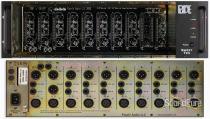-
Call Us Toll Free888-528-9703
-
Local/International (+1)919-682-5552
- Call Us! Toll Free! 888-528-9703
- Local / International (+1) 919-682-5552

AEA RPQ500 500-Series 2 Mic Preamp From AEA
The ultimate low-noise 500-series preamp optimized for ribbons just got that much better! The new RPQ500 features an even higher impedance value and a slick new visual facelift, on top of its already exceptional low-noise performance and wildly smooth Curve Shaper EQ.
$699.00
"Experience the Difference"
 Payments as low as $61/mo.
Payments as low as $61/mo.
What We Think
The original RPQ was one of our favorite preamps, so we got incredibly excited when we first heard wind of a new version of both the 19" and 500-series formats. Increasing the impedance value to an insanely high 63k ohms brings out an even broader frequency response and improved transient detail for the best performance possible out of your ribbon mic collection. AEA even increased the range of their high-pass filter up to 515Hz to give you, even more, control over the low-end content you may not wish to capture, for example when you're after just cymbals and upper-mid drum "smack" on overheads.
Whether it's helping you get the best performance out of your ribbons, opening up your mix using it's "Curve Shaper" EQ, or achieving exceptionally low-noise performance with your condensers, the RPQ2 is a stunning EQ every engineer needs to be aware of. Give us a call today to talk about our favorite applications and mic combinations with the RPQ2!
Manufacturer's Description from AEA
The Versatile Mic Pre in the 500 series format
- One channel with 81dB of sweet and quiet JFET gain for all mics
- High frequency CurveShaper™ EQ and low frequency proximity control
- Mic and line inputs for mixdown EQ versatility
- Switchable phantom power, polarity, line/mic, and EQ inserts
- NoLoad™ 10k Ohm high-impedance circuitry providing better overall transients, frequency response, and higher output sensitivity
The RPQ500 module, designed after the successful RPQ preamp, provides the same ultra-clean, high-gain signal path that has earned AEA preamps their great reputation, but in a 500 series package. JFET circuit topology provides all the dynamics, subwoofer bass, and fast transients that your microphones can record. The NoLoad™ input impedance above 10K Ohms means the RPQ won’t load down a mic and change its sound. Low Energy Storage™ circuit design instantly recovers from overloads for superior dynamic performance. The original RPQ with CurveShaper™ was designed to fully capture every nuance of ribbon microphones: vintage or modern, passive or phantom powered. Engineers have discovered that the RPQ500 also complements their moving coil, condenser mics. By virtue of its sonic qualities and versatility, the VPR Alliance approved AEA RPQ500 is the tool of choice for all microphones whenever a true and pristine signal path is desired.
Two Peas in a Pod: Musical Preamp, Sweet EQ
The CurveShaper’s™ high-frequency filter boost enables you to add a little extra “presence” or “air” to your source. The circuit functions similarly to a conventional parametric shelving boost, but with a significant difference: the slope varies as both the CurveShaper™ and HF Gain controls are adjusted. This unique bell curve was designed with the intention to compensate for the high-frequency roll-off that is inherent to most ribbon microphones. But beyond ribbon mics, the smooth HF filter is remarkably well suited for brightening up condenser mics used at a distance, restore the presence in overly “dry” acoustical environments, or even as a clean and transparent air-band boost on the 2-bus.
The CurveShaper’s™ low-frequency control easily removes boxiness and boominess in a fast and unobtrusive way. Ribbon mics are capable of delivering strong subwoofer lows, and can have a significant bass proximity effect. Such strong low-frequency content can mask high-frequency intelligibility, so the tunable LF filter was engineered to tame low-frequency energy to appropriate levels. Its -20dB shelving curve is ideally suited to reduce excessive proximity effect, opening up new possibilities to use ribbon mics in close-up applications.
Your Sound At Your Fingertips
With mixing consoles disappearing from control rooms, dedicated preamps can take on the role of providing a high-quality front end giving you intuitive control to make critical decisions during tracking rather than “fixing it in the mix”. The RPQ500 is a workhorse tool for your API 500 compatible rack. The Line/Mic switch bypasses the microphone gain stage and allows the EQ to be used for tracking with other preamps or during mixdown. Add the output level control, and the RPQ500 becomes a high-quality processing tool that can be used for mixing and mastering when combined with summing racks and mixers such as the Purple Audio moyin the Roll Music Folcrom.

About Manufacturer
Wes Dooley's longtime passion for audio has infused his company, Audio Engineering Associates (AEA), with a well balanced blend of creativity and technical expertise for forty years. At the core of AEA is a genuine interest in the art and science of audio. From areas as diverse as forensic audio and microphone design, Wes' passion for audio has led him all over the world, from recording experiences in Europe, Africa, and New Zealand, to the courtrooms of Los Angeles as a forensic audio and video expert witness. Such experiences have led Wes to design products which help resolve problems commonly encountered by recording engineers. His portable recording tools including, multi-channel microphone arrays, MS stereo processors, stereo phase displays and very tall microphone stands, have all made on-site recording far more feasible. Despite his contributions to on-location recording, Wes is best known for his pursuit of excellence in ribbon microphone technology. After two decades of representing and servicing the BBC 4038 in the United States, he began to experiment with his own ribbon microphones. During the last decade Wes became aware of the increasing scarcity of R44's and other ribbon microphones. In 1998, responding to this need, Wes re-introduced the 44 much to the thrill of many in the recording industry. Les Paul told Wes that AEA's R44 is his favorite microphone and engineer/producers such as Bruce Swedien, Kevin Bacon, and Shawn Murphy routinely use AEA's R44. Even without such critical acclaim the numbers speak for themselves. Over half of the movies scored in Los Angeles have a 44 somewhere on the scoring stage. Building off of his successful reintroduction of the R44, in 2002 Wes designed and began producing an original ribbon mic, the AEA R84. His groundbreaking work with ribbon microphones helped him to secure the Audio Engineering Society (AES) Silver Medal Award in the fall of 2003. This award, established by the AES in 1971, in honor of audio pioneers Alexander Graham Bell, Emile Berliner, and Thomas A. Edison, is given in recognition of outstanding development or achievement in the field of audio engineering. Wes has also co-authored two AES Journal articles about stereo microphone techniques, chaired workshops on mic techniques and mixing strategies for compatible multiple releases for cinema, broadcast and home video, and has presented section meetings on stereo techniques and forensic audio. He is involved with AES standards work and currently serves on the SC-03-12 Working Group on Forensic Audio and SC-04-04 Working Group on Microphone Measurement and Characterization.
Specifications
- Gain at 1kHz: 81dB of gain at 1kHz, balanced in and balanced out in Microphone Input Mode
- Noise figure, RMSrims A-weighted: < 2dB
- Noise figure, RMS unweighted: < 3dB, 20 kHz LPF bandwidth
- EIN: < -130 dBu A-weighted, 150 Ohm resistive source
- Frequency response: -3dB < 1Hz and > 100 kHz
- THD: < 0.02% at 1 kHz
- Input impedance: 10K Ohms
- Balanced Line Input Impedance: 20K Ohms
- Input Gain control: Twelve-position switch provides from +13dB to +62dB of gain for the preamplifier circuit, as measured between the input and the before the output line driver.
- Switched LF Shelving filter: -3dB break-frequency tunable from 18 Hz to 360 Hz; maximum reduction -20dB.
- Switched CurveShape EQ: +3dB break-frequency tunable from 2.5 kHz to 30 kHz; HF gain adjustable from +0 dB to +18 dB; the slope of the HF filter varies interactively and directly with the CurveShaper™ frequency and gain settings
- Color LEDs: Green, Yellow, Red
- XLR output maximum level into 600Ω load: +28 dBu, balanced; 0 dBu = 0.7746 Vrms
- XLR connectors polarity: Pin-1 is ground, pin-2 is high, pin-3 is low
- LED signal level indicators: Green snaps on at -6 dBu, red snaps on at +23 dBu, and yellow varies in brightness with level from -3 dBu to +20 dBu.
















